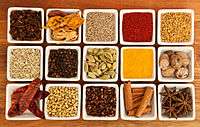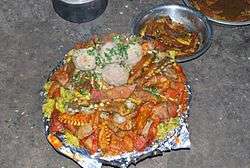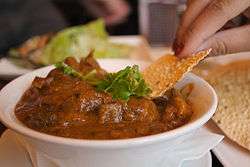Kashmiri cuisine
Kashmiri cuisine is the cuisine of the Kashmir Valley of India. Rice is the staple food of Kashmiris and has been so since ancient times.[1] Meat, along with rice, is the most popular food item in Kashmir.[2] Kashmiris consume meat voraciously.[3] Despite being Brahmin, most Kashmiri Hindus are meat eaters.[4]
 |
| This article is part of the series on |
| Indian cuisine |
|---|
|
Regional cuisines
|
|
Ingredients, types of food
|
|
See also
|
|
Related cuisines |
|
Kashmiri cuisine
Some noted Kashmiri dishes include:
- "Tabakhmaaz" (Kashmiri Hindus commonly refer to this dish as Qabargah)
- Shab Deg: dish cooked with turnip and meat, left to simmer overnight.[5]
- Dum Olav/Dum Aloo: cooked with ginger powder, fennel and other hot spices.
- Aab Gosh
- Goshtaba
- Lyader Tschaman also called as Chaman Kaliya
- Runwagan Tschaman, Cottage cheese in tomato gravy
- Riste Meat balls in a delicious curry
- Nader ti Gaad, Fish cooked with lotus stem, a delicacy cooked on festival days like Eid, Novroze and Gaadi Batti ( Festival of Kashmiri Pandits )
- Machwangan Kormeh, meat cooked with spices and yogurt and mostly using kashmiri red chillies and hot in taste
- Matschgand, lamb meatballs in a gravy tempered with red chillies.
- Waazeh Pulaav
- Monje Haakh kholrabi being a delicacy
- Haakh (wosteh haakh, haenz haakh among others) collard greens is enjoyed by Kashmiri people and they have their own versions of cooking the same with cottage cheese, mutton or chicken.
- Mujh Gaad, a dish of radishes with a choice of fish.
- Daniwal Kormeh Lamb cooked with coriander or parsley.
- Rogan Josh, a lamb based dish, cooked in a gravy seasoned with liberal amounts of Kashmiri chillies (in the form of a dry powder), ginger (also powdered), garlic, onions or asafoetida , gravy is mainly Kashmiri spices and mustard oil based.
- Yakhni, a yoghurt-based mutton gravy without turmeric or chilli powder. The dish is primarily flavoured with bay leaves, cloves and cardamom seeds. This is a mild, subtle dish eaten with rice often accompanied with a more spicy side dish.
- Harissa is a popular meat preparation made for breakfast, it is slow cooked for many hours, with spices and hand stirred.
Other foods
The Kashmir Valley is noted for its bakery tradition. On the Dal Lake in Kashmir or in downtown Srinagar, bakery shops are elaborately laid out. Bakers sell various kinds of breads with golden brown crusts topped with sesame and poppy seeds. Tsot and tsochvor are small round breads topped with poppy and sesame seeds, which are crisp and flaky, sheermal, baqerkhayn (puff pastry), lavas (unleavened bread) and kulcha are also popular. Girdas and lavas are served with butter.
Kashmiri bakerkhani has a special place in Kashmiri cuisine. It is similar to a round naan in appearance, but crisp and layered, and sprinkled with sesame seeds.[6] It is typically consumed hot during breakfast.[7]
Wazwan

A Wazwan is a multi-course meal in the Kashmiri Muslim tradition and treated with great respect. Its preparation is considered an art. Almost all the dishes are meat-based (lamb, chicken, mutton but never fish). It is considered a sacrilege to serve any dishes based around pulses or lentils during this feast. The traditional number of courses for the wazwan is thirty-six, though there can be fewer. The preparation is traditionally done by a vasta waza, or head chef, with the assistance of a court of wazas, or chefs.
Wazwan is regarded by the Kashmiri Muslims as a core element of their culture and identity. Guests are grouped into fours for the serving of the wazwan. The meal begins with a ritual washing of hands, as a jug and basin called the tasht naèr (tasht-e-naari in Urdu/Persian) is passed among the guests and their hands are being washed. Afterwards, Dastarkhan is spread and a large serving dish piled high with heaps of rice, decorated and quartered by two seekh kabab, four pieces of meth maaz, two tabak maaz, sides of barbecued ribs, and one safed kokur, one zafrani kokur (Kong Kokur in Kashmiri), and a mutton dish consisting of a piece known as Danni phol, sprinkled over with some coriander and Musk Melon seeds,followed by waza serving other dishes like Risteh, roganjosh, aab gosht, runwangan tchaman, marchwangan kormeh, aloo bukhara gosht, Daniwal kormeh, wazz palak, hindi roganjosh, sindhi roganjosh, matxh, botehcxear maaz(apricot mutton curry) last but not the least Gushtaab/Gushtaba including others. The meal is accompanied by yoghurt garnished with Kashmiri saffron, salads, Kashmiri pickles and dips. Afterwards, the Dastarkhan is rolled off and the guests are again made to wash their hands. It is usually followed by Phirni/Phireen or Halwa and/or IceCreams and Soft Drinks along with mouth freshners. Kashmiri Wazwan is generally prepared in marriages and other special functions. The culinary art is learnt through heredity and is rarely passed to outside blood relations. That has made certain waza/cook families very prominent. The wazas remain in great demand during the marriage season from May–October.
.jpg)
_with_Vendor_-_Old_City_-_Srinagar_-_Jammu_%26_Kashmir_-_India_(26564862530).jpg)
Beverages
Kashmiri Chai, Noon Chai, or Sheer Chai
Kashmiris are heavy tea drinkers. The word "noon" in Kashmiri language means salt. The most popular drink is a pinkish colored salted tea called "noon chai."[8] It is made with black tea, milk, salt and bicarbonate of soda. The particular color of the tea is a result of its unique method of preparation and the addition of soda. The Kashmiri Hindus more commonly refer to this chai as "Sheer Chai." The Kashmiri Muslims refer to it as "Noon Chai" or "Namkeen Chai" both meaning salty tea.
Noon Chai or Sheer Chai is a common breakfast tea in Kashmiri households and is taken with breads like baqerkhani brought fresh from Qandur, or bakers. Often, this tea is served in large samovars.
Kahwah
At marriage feasts, festivals, and religious places, it is customary to serve kahwah - a green tea made with saffron, spices, and almonds or walnuts. Over 20 varieties of Kahwah are prepared in different households. Some people also put milk in kahwah (half milk and half kahwah). This chai is also known as "Maugal Chai" by some Kashmiri Hindus from the smaller villages of Kashmir. Kashmiri Muslims and Kashmiri Hindus from the cities of Kashmir refer to it as Kahwah or Qahwah.
References
- Bamzai, Prithivi Nath Kaul (1994). Culture and Political History of Kashmir. M.D. Publications Pvt. Ltd. p. 243. ISBN 9788185880310.
Rice was, as now, the staple food of Kashmiris in ancient times.
- Kaw, M.K. (2004). Kashmir and Its People: Studies in the Evolution of Kashmiri Society. APH Publishing. p. 98. ISBN 9788176485371.
But perhaps the most popular items of the Kashmiri cuisine were meat and rice.
- Press, Epilogue. Epilogue, Vol 3, issue 9. Epilogue -Jammu Kashmir.
Since Kashmiris consume meat voraciously and statistics reveals that on an average 3.5 million sheep and goat are slaughtered annually for our consumption, the skin can be utilised for production.
- Dar, P Krishna (2000). Kashmiri Cooking. Penguin UK. ISBN 9789351181699.
Though Brahmins, Kashmiri Pandits have generally been great meat eaters.
- Kashmiri Meat Shabdeg
- "Culture of Anantnag". District Anantnag J&K. Archived from the original on 19 June 2009.
- "Kashmir has special confectionary". Thaindian.com. 13 March 2008. Retrieved 18 July 2013.
- "Shier Chay". Archived from the original on 21 May 2012.
Further reading
| Wikimedia Commons has media related to Cuisine of Kashmir. |
- "Chor Bizarre". Wazwan. Archived from the original on 23 December 2005. Retrieved 16 December 2005.
- "Kashmiri Cuisine". Kashmiri Cuisine- food and recipes:Mumbai/Bombay pages. 9 September 2000. Retrieved 16 December 2005.



